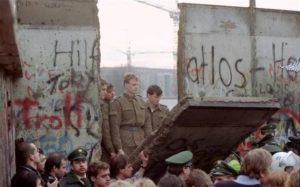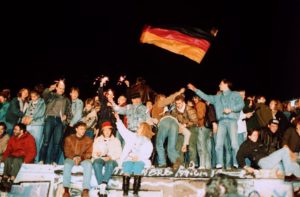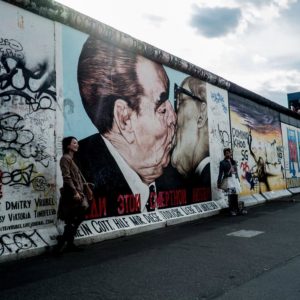Continua la collaborazione tra il liceo linguistico "Cattaneo dall'Aglio" e Redacon tramite la rubrica "Speakeasy" curata direttamente dagli studenti, dell'anno scolastico 2019-2020.

About five months ago, on the occasion of the anniversary of the fall of the Berlin Wall, we talked about celebrations in the previous article about the Wall: “The fall of the wall was like the fall of prejudice, it was the starting point of civilization and globalism. For people all around the world it was an event which gave them liberty and more rights.”
This is true but there is also a downside, as two articles from The Guardian show.
The first article is an editorial which gives an alternative view on the fall of the Berlin Wall. The event was at first considered the definitive triumph of liberal democracy. But thirty years later, the event looks rather different.
Wisdom and understanding only come with hindsight. This means that we need time to understand how history will work out.

The event of 9 November 1989 was seen by many people as the definitive victory of liberal democracy and in fact, for 20 years or so, Europe seemed to support liberalism. As the EU expanded eastwards, the former Warsaw Pact countries democratised, privatised state assets and grew considerably richer, despite economic losses and serious difficulties along the way.
As stated by The Guardian, three decades after the destruction of the Wall, the liberal consensus has become fragile. Indeed, this feels like an equivocal anniversary. In eastern Europe, rightwing nationalist parties have sprung up in the smaller towns and rural areas that have seen little of the wealth accumulated in capitals such as Warsaw and Budapest, and have suffered as young people have emigrated. Barriers have appeared again to keep out refugees and migrants, for example on Hungary’s eastern borders. These fences represent “illiberal democracy” that targets minorities and disregards universal human rights. Another example of “illiberalism” is the latest victory of the far-right nationalist AfD in state elections in the east German state of Thuringia.
The rise of an aggressive rightwing populist nationalism has not been confined to the east but is also present in Italy, France and in the UK, where the Brexit referendum result can also be, in part, due to weaknesses in the liberal thinking which remade Europe with supreme self-confidence after 1989. Too little attention was paid to the regions, places and individuals which lost out in the emerging single market. Over the last 30 years, societies grew wealthier but also more divided, as governments took a back seat and allowed market forces to dictate. This means that economy is more powerful than governments or politics.
There are tentative signs that some necessary rethinking may be under way. As Macron said: “Europe has forgotten that it is a community, by increasingly thinking of itself as a market, with expansion as an end purpose”. He would like to see a common eurozone budget, with real fiscal power, to enable a fairer distribution of wealth and resources across the EU.
In the second article, journalist Neal Ascherson talks about how now, in place of the Berlin Wall, stands a wall of hostile resentment. In fact, this reunification has only fed bitterness and alienation among the “losers” of the old East Germany.
But then, once in a lifetime
The longed-for tidal wave
Of justice can rise up
And hope and history rhyme.
Neal Ascherson uses these lines by Seamus Heaney from “The cure at Troy” (Sophocles’ Philoctetes) in order to describe what really happened when the Berlin Wall fell. After the night of the fall, the popular rising turned into Heaney’s “longed-for tidal wave” which is a metaphor to define the overflow of the desire for justice at last that, seeping into the confident minds of the Communist party officials, turned them into bundles of uncertainty.

The tide was European. Long before the wall opened, the Soviet empire had begun to dissolve. In Poland that June, the Communist party had been defeated in almost-free elections and a gentle Catholic intellectual had become Prime Minister. In August, the peoples of the Baltic republics called for independence.
Nobody likes to remember that within the cold war there was a cold civil war – between East and West Germany. In fact, the Berlin Wall only helped the slow alienation of one Germany from the other. The easterners longed to travel to the west but, after 40 years under a different social system, they had only a diminishing wish to live there. At the same time, West Germans grew increasingly ignorant and patronising about the east. Both “nations” belonged to Germany but they were growing differently, it was as if two nations were emerging: twins, but not identical twins.
Unification in 1990 only led to the intensification of the cold civil war between those two nations: the West German “victors” took over and exploited the “losers” of East Germany until it felt more like an annexation than a reunification.

Even today, thirty years after the fall of the wall, the differences between East and West Germany are still evident. Indeed, in East Germany extreme rightwing politics flourish and there’s a sense of a lost social culture, which was certainly founded on lies and on a police state but offered a sort of identity. Walls might come down but walls in the mind take much longer to demolish and in fact, what remains is resentment, a sense of disrespected difference and a deeply conservative worldview.
In conclusion, the fall of the Berlin Wall brought freedom and hope. But with hindsight, the lessons of 1989 look different; they tell us that a recalibration of the relationship between governments and the market is necessary, and might stop the nationalist surge in both east and west.
The redacon article about the Berlin Wall:
The Guardian view on the fall of the Berlin Wall: history’s lessons:
In place of Berlin’s Wall now stands a barrier of sullen resentment:
(Alessia Bassoli, Beatrice Ganapini e Giada Marotta, 5ªQ, Liceo Linguistico Dall’Aglio)
***
Il muro di Berlino: un muro di risentimento?
Circa cinque mesi fa, in occasione dell’anniversario della caduta del muro di Berlino, abbiamo parlato di festeggiamenti nel precedente articolo riguardo al muro: “La caduta del muro fu come la caduta dei pregiudizi, fu il punto d'inizio di una civiltà diversa e della globalizzazione. Per le persone provenienti da tutte le parti del mondo fu un evento che diede loro libertà e più diritti.”
Questo è vero, ma c’è anche un lato negativo, come mostrano due articoli tratti da “The Guardian”.
Il primo articolo è un editoriale che dà una visione alternativa sulla caduta del muro di Berlino. L’evento fu inizialmente considerato il trionfo definitivo della democrazia liberale. Ma trent’anni dopo, ciò che è accaduto può essere visto con occhi diversi. Saggezza e comprensione arrivano solo col senno di poi. Ciò significa che abbiamo bisogno di tempo per capire come la storia si evolverà.
L’evento del 9 novembre 1989 è stato visto da molti come la vittoria definitiva della democrazia liberale e infatti, per circa vent'anni, è sembrato che l’Europa supportasse incondizionatamente il liberalismo. Quando l’Europa si espanse verso est, i precedenti paesi del Patto di Varsavia si democratizzarono e privatizzarono i beni statali e crebbero notevolmente in ricchezza, nonostante perdite economiche e serie difficoltà lungo il percorso.
Come indicato da The Guardian, tre decenni dopo la distruzione del muro il consenso liberale è diventato fragile. In effetti, questo anniversario è stato percepito come equivoco. Nell’Europa orientale, partiti nazionalisti di destra sono comparsi nelle piccole città e aree rurali, che hanno visto poco della ricchezza accumulata nelle capitali come Varsavia e Budapest, e hanno sofferto quando i loro giovani sono emigrati. Nuovi muri sono stati innalzati per tenere fuori i rifugiati e i migranti, per esempio alla frontiera dell’Ungheria orientale. Queste barriere rappresentano la “democrazia illiberale” che prende di mira le minoranze e ignora i diritti umani universali. Un altro esempio di “illiberalismo” è la recente vittoria dell’AfD, partito nazionalista di estrema destra, nelle elezioni statali nello stato della Turingia nell’est Germania.
La crescita di un nazionalismo populista di estrema destra non è limitata all’est ma è presente anche in Italia, Francia e Regno Unito, dove il risultato del referendum sulla Brexit può essere anche, in parte, dovuto alle lacune nel pensiero liberale, che ricreò l’Europa con suprema autostima dopo il 1989. Fu prestata troppa poca attenzione alle regioni, ai luoghi e agli individui che si sono trovati dalla parte dei perdenti nell’emergente mercato unico. Nel corso degli ultimi trent’anni, le società sono diventate più ricche ma anche più divise, dal momento in cui i governi si sono fatti da parte e hanno permesso alle forze di mercato di prendere le decisioni importanti. Ciò significa che l’economia è più potente dei governi o della politica.
Ci sono segni incerti che un necessario ripensamento possa essere in corso. Come ha detto Macron: “L’Europa ha dimenticato di essere una comunità, pensando sempre di più a sé stessa come a un mercato, con l’espansione come fine ultimo”. Il Presidente francese vorrebbe vedere un bilancio comune dell’eurozona, con vero potere fiscale, per permettere una distribuzione della ricchezza e delle risorse più equa in tutta l’Unione Europea.
Nel secondo articolo, il giornalista Neal Ascherson parla di come adesso, al posto del muro di Berlino, si trova un muro di ostile risentimento. Infatti, questa riunificazione ha solo alimentato rancore e alienazione tra i “perdenti” della vecchia Germania Est.
Ma poi, una volta nella vita
La tanto desiderata marea
Di giustizia può alzarsi
E speranza e storia rimare
Neal Ascherson usa questi versi di Seamus Heaney da “The cure at Troy” (Filottete di Sofocle) per descrivere quello che veramente accadde con la caduta del muro di Berlino. Dopo la notte della caduta, l’insurrezione del popolo si tramutò nella “tanto desiderata marea” di Heaney che è una metafora per definire lo straripare del desiderio per la giustizia che infine, penetrando nelle menti sicure di sé degli ufficiali del partito Comunista, le fece sprofondare nell’incertezza.
La marea era europea. Molto tempo prima dell’apertura del muro, l’impero Sovietico aveva iniziato a dissolversi. In Polonia quel giugno, il partito Comunista era stato sconfitto in elezioni quasi libere e un gentile intellettuale Cattolico era diventato Primo Ministro. In agosto, i popoli delle repubbliche Baltiche chiesero l’indipendenza.
A nessuno piace ricordare che all’interno della guerra fredda c’era anche una guerra fredda civile tra la Germania Est ed Ovest. Infatti, il muro di Berlino non fece altro che aiutare la lenta alienazione di una Germania dall’altra. Le genti dell’est avevano desiderato spostarsi ad ovest ma, dopo 40 anni sotto un sistema sociale diverso, desideravano sempre meno viverci. Allo stesso tempo, i tedeschi dell’ovest diventarono sempre più ignoranti e paternalistici verso l’est. Entrambe le “nazioni” appartenevano alla Germania ma si stavano sviluppando diversamente, era come se due nazioni stessero emergendo: gemelle, ma non gemelle identiche.
L’unificazione del 1990 portò solamente all’intensificazione della guerra fredda civile tra queste due nazioni: i “vincitori” della Germania Ovest presero il controllo e sfruttarono i “perdenti” della Germania Est, tanto che alla fine sembrò più un'annessione che una riunificazione.
Anche oggi, trent’anni dopo la caduta del muro di Berlino, le differenze tra l’est e l’ovest sono evidenti.

Infatti, nella Germania Est l’estrema destra cresce e c’è un senso di aver perso una cultura sociale che era certamente fondata su bugie e su uno stato di polizia, ma che offriva una forma di identità. I muri possono cadere ma i muri nella mente ci mettono più tempo a crollare e, infatti, quello che rimane è risentimento,la sensazione di non vedere rispettate le proprie differenze e una visione del mondo profondamente conservativa.
In conclusione, la caduta del muro di Berlino portò libertà e speranza. Ma col senno di poi, le lezioni del 1989 sembrano diverse; ci dicono che una ricalibrazione della relazione tra i governi e il mercato è necessaria e che questa potrebbe fermare l’ondata di nazionalismo sia ad est che ad ovest.
(Alessia Bassoli, Beatrice Ganapini e Giada Marotta, 5ªQ, Liceo Linguistico Dall’Aglio)







